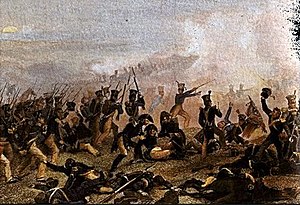Battle of Lundy's Lane
| Battle of Lundy's Lane | |||||||
|---|---|---|---|---|---|---|---|
| Part of the War of 1812 | |||||||
 US infantry attacks at Lundy's Lane. Painting by Alonzo Chappel in 1859. |
|||||||
|
|||||||
| Belligerents | |||||||
|
|
|
||||||
| Commanders and leaders | |||||||
|
Gordon Drummond (WIA) Phineas Riall (WIA) |
Jacob Brown (WIA) Winfield Scott (WIA) Eleazer Ripley |
||||||
| Strength | |||||||
|
At start: 1,800: 5 guns Reinforcements: 1,700: 3 guns Total: 3,500, 8 guns |
At start: 1,000: 3 guns Reinforcements: 1,500: 6 guns Total: 2,500, 9 guns |
||||||
| Casualties and losses | |||||||
| 84 dead 559 wounded 169 captured 55 missing Total: 878 |
174 dead |
||||||
| Official name | Battle of Lundy's Lane National Historic Site of Canada | ||||||
| Designated | 1937 | ||||||
Coordinates: 43°05′21″N 79°05′44″W / 43.089152°N 79.095456°W
174 dead
572 wounded
79 captured
28 missing
Total: 853
The Battle of Lundy's Lane (also known as the Battle of Niagara Falls) was a battle of the Anglo-American War of 1812, which took place on 25 July 1814, in present-day Niagara Falls, Ontario. It was one of the bloodiest battles of the war, and one of the deadliest battles ever fought in Canada.
The battle was a tactical draw but a British strategic victory because the Americans had suffered so many casualties that they were now outnumbered. There were over 1,500 casualties including 258 killed.
On 3 July 1814 an American army under Major General Jacob Brown launched an attack across the Niagara River near its source on Lake Erie. His force quickly captured the British position at Fort Erie and then advanced north. Two days later one of his two brigades of regular U.S. Infantry under Brigadier General Winfield Scott defeated a British force commanded by Major General Phineas Riall at the Battle of Chippawa.
A few days after the battle Brown outflanked the British defences along the Chippawa River and the British fell back to Fort George near the mouth of the Niagara on Lake Ontario. Brown lacked the necessary troops and heavy artillery to attack this position. At the time a British naval squadron controlled the lake. Commodore Isaac Chauncey, commander of the American ships based at Sackett's Harbor, New York, was waiting for new frigates and heavily armed brigs to be completed before he could challenge the British squadron. When these were finally ready to sail, the American squadron was further delayed in port when Chauncey fell ill. As a result, no reinforcements or heavy guns could be sent to Brown while the British were able to move several units across the lake from York to reinforce Fort George.
...
Wikipedia
